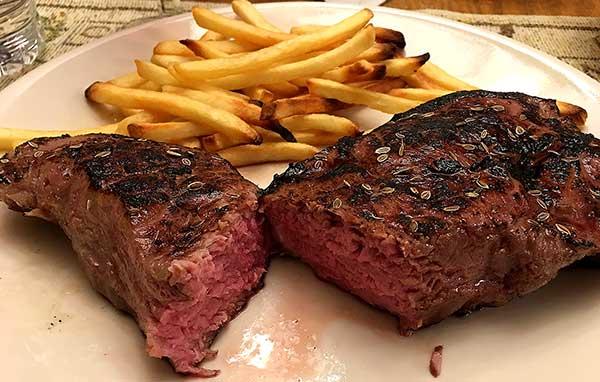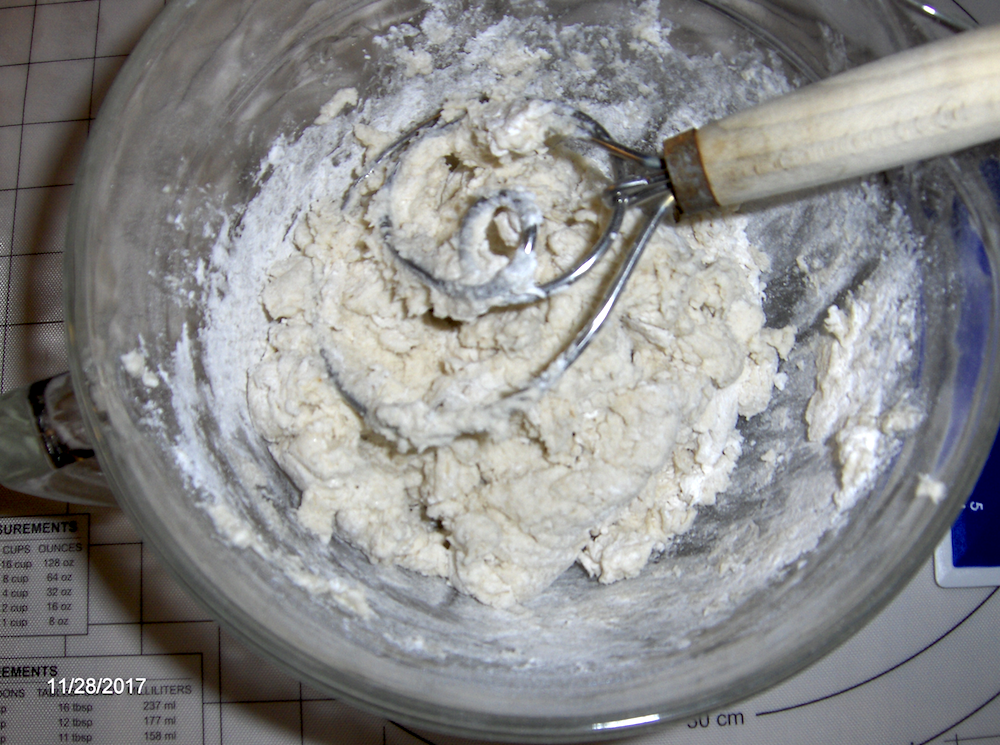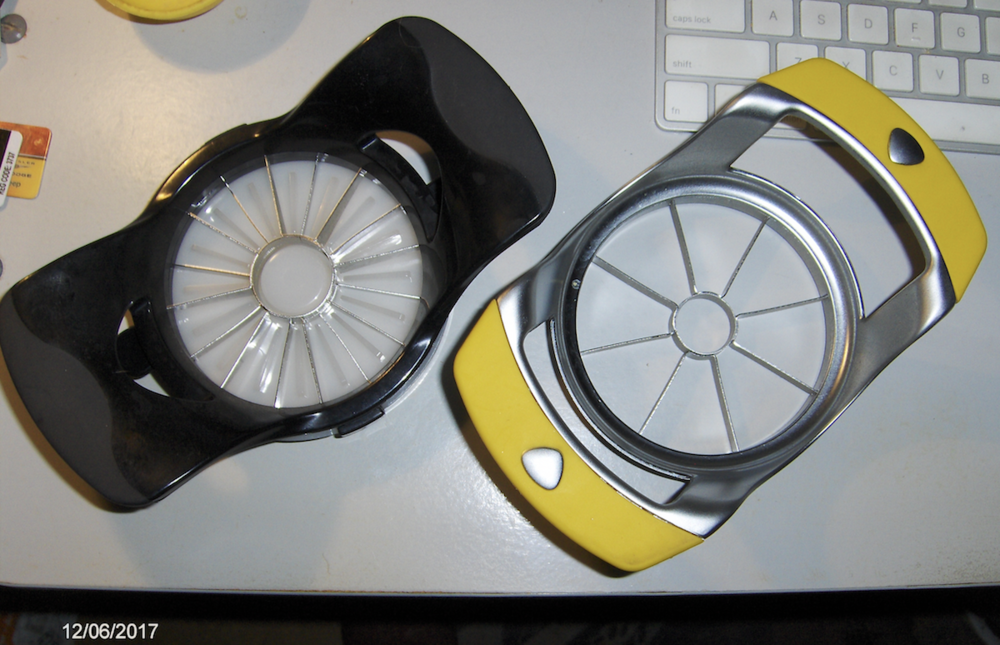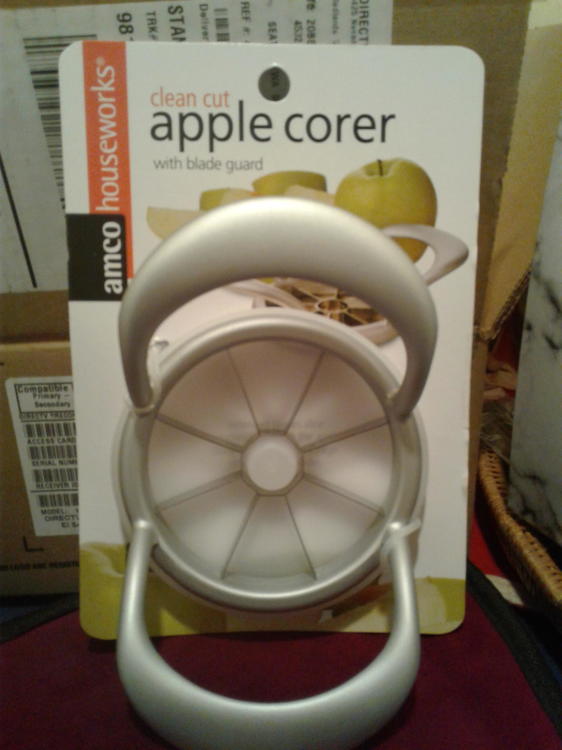
boilsover
-
Posts
918 -
Joined
-
Last visited
Content Type
Profiles
Forums
Store
Help Articles
Posts posted by boilsover
-
-
16 hours ago, boilsover said:
Any bets on weight differences after 6 hours? I'm not adding green dye to prime beef sorry. You'll have to trust/excuse me reporting any taste differences.
So, after 6 hours, the tray-marinated tritip weighed 1/4 oz more. The vacuum one added just shy of 1/2 oz. This is consistent with the Young & Smith 2004 chicken study. I couldn't taste a difference, and I did not weigh after cooking.
I'm duplicating the test today with Jaccarded identical 7 1/4 oz triptips, one in the tray and one under vacuum.
Eating prime beef for science... I hope you all appreciate my sacrifice...
-
 1
1
-
 1
1
-
-
5 minutes ago, btbyrd said:
Adsorbs marinade.
"Neither of the second set of sources that I linked to mention beef."
Mentions beef. Feel better?
-
3 minutes ago, btbyrd said:
The Jaccarding technique I was suggesting is purely mechanical and relies on the use of the vacuum bag to push the marinade into the channels created by the needler. If you coat needled meat and put it in a vacuum chamber, there's nothing to press the marinade into the holes, so I wouldn't expect that to be a useful way to do it.
A quick reply to your other points:
- I don't know why beef would be magically different than fish or chicken. If anything, I'd expect it to uptake even less marinade since it's more dense and robust than chicken and fish, which can be easily damaged at high vacuum levels.
- Genuine Ideas is legit, and I trust it more than intuitions, industry lore, and marketing nonsense put forward by manufacturers of vacuum marinaders/tumblers. Dave Arnold cites it; I don't feel bad about citing it either.
- Neither of the second set of sources that I linked to mention beef. The section you quoted is about chicken. That quote is also about the vacuum tumbling process, not vacuum marination per se. They attribute the difference in yield and uptake to tumbling rather than vacuum level.
- As for the third study and its limited vacuum marination time, I don't think that matters. If you've ever made instant pickles or compressed watermelon in a vacuum machine, you know it only takes 30 seconds to shove a whole bunch of brine into something. It is almost instant. If there's no difference in uptake after 30 minutes, I don't think giving it more time is going to change things.
By this logic, there should be almost no uptake at all.
Clearly, cut, exposed meat exchanges moisture with its environment. While it is wrong to think of it as a sponge, it's also wrong to consider it not to absorb marinade.
-
3 hours ago, btbyrd said:
Sure. Genuine Ideas did a blog post on this called "Vacuum Marination Sucks" that provides a good overview. If you want to go down the meat science journal rabbithole, researchers at the University of Georgia and the USDA have repeatedly (1) found (2) that vacuum levels have no effect on the uptake of marinade by chicken. They conclude that "vacuum pressure during tumbling, as is widely practiced commercially, may not be necessary. The underlying principles for using vacuum pressure may be erroneous and should be examined further." Another study on the effect of vacuum marination on fish found that ""contrary to conventional industry belief, vacuum (9.2 kPa) during tumbling did not affect uptake of marinade." These articles suggest that the perceived benefits of marinating in a vacuum tumbler actually come from the tumbling, not the vacuum.I have yet to put a vaccum selaed bag of marinating meat in my dryer, but I can't say that I haven't considered it.
I've read these linked sources. None addresses beef. The first is almost completely devoid of data, and the illustrations appear completely fictional, apparently designed to support the conclusion.
The second, about chicken, actually acknowledges that vacuum *does* increase uptake in beef: "The vacuum tumbling process has been shown to increase marinade uptake in the meat (Young and Lyon, 1997; Young and Smith, 2004) and improve cook yield (Young and Lyon, 1997; Young et al., 2004)." Here, the time period was only 1 hour.
The third linked study, also about chicken, had a marination time period of only 30 minutes.
The fourth addressed halibut. Unfortunately, all I could access was the abstract, which indicates that testing vacuum uptake wasn't the focus of the article.
My curiosity has inspired me to cut 3 identical tritips (7 1/4oz) each. One sits just in a shallow tray at ambient pressure, the second is under vacuum in a Vac-u-Vin cannister (shaken a few times to make sure marinade coats the cut) and the third one Jaccarded and in the same vacuum environment. Equal volume of marinade in each.
Any bets on weight differences after 6 hours? I'm not adding green dye to prime beef sorry. You'll have to trust/excuse me reporting any taste differences.
-
21 hours ago, btbyrd said:
The benefits of vacuum marination are much exaggerated... Meat is dense. It is not like a sponge, and won't "suck up" marinades appreciably faster under vacuum.
Hmmm, do you have any data supporting this?
I certainly get that needled tissue will take up marinade faster than non-, but I question whether meat is so dense that it will not absorb marinade faster under vacuum. It would seen to me that, while not significantly porous, there is clearly enough "room" for water and salt (and blood, serum and lymph) to pass through and between muscle cells, and vacuum would aid with that, even without needling.
I guess I have to run a little test.
In this connection, I've heard it's the practice of markets like Costco and Walmart to needle pretty much everything.
-
29 minutes ago, cakewalk said:
Copper is a color.
And if you've ever been around real copper, you know it's a completely different color...
-
2 hours ago, IndyRob said:
After doing my rounds this holiday season, I've come to the conclusion that we may need to increase the size of all the big box stores in order to accommodate all of this new 'copper' cookware.
What the heck is going on?
Hella marketing is what's going on. Carry on.
-
10 hours ago, jmacnaughtan said:
If you don't have a massive power output on your burner, add some butter to the pan. It'll help with the colour and taste better (as long as you don't burn it).
Although, for thicker steaks, I now use the Alain Ducasse method.
Actually I do have up to 180K Btu available, and I'm with you about butter. Because of the high temps I'm using with searing the SV'd steaks, if I want butter/diacetyl flavor, it gets ghee and oil for the sear, and then a little whole or compound butter at the finish.
The Ducasse/Fat Guy method was also my mom's (wife of the butcher) --the crust is incredible. Personally, I prioritize that crust ahead of the (relative) lack of gradient with SV.
Now I'm thinking of a la Mom/Ducasse, except starting with the raw steak chilled...
Next "Steak SV" question: I have had good luck with "marinating" steaks overnight in a vacuum cannister with olive oil, garlic and herbs. I think the acids in the oil improve the texture, and the aromats infuse the meat. I have not noticed this texture improvement with my SV cooks, but the flavor infusion has been OK. Do you SV experts think you get equal or greater benefits from doing that in a non-vacuum SV bag in a 1-2 hour SV cook? In other words, do you get much, besides heat, that you wouldn't get from a vacuum marinade?
-
3 minutes ago, mgaretz said:
I use a torch (part of the Sansaire searing kit) and I put it on my stovetop so I can run the extractor fan. But the secret is to dust the steak (after patting dry) with dextrose. Some use a dextrose/baking soda mix to create a more alkaline environment for the browning reaction. But I can taste the baking soda and it is gritty so I just use dextrose. I haven’t found any difference in the browning. The cheapest place to get dextrose will be a local home brew supply shop. I have mine in a screen top shaker.
Ooh, that looks good. I knew of the dextrose/soda thing from wok preps like Mongolian Beef, but I didn't think of it for steaks.
Homebrew here I come.
-
9 minutes ago, btbyrd said:
...the overall time your meat will have to spend in a hot pan is less.
I have to think about that. Deep frying conducts the heat from the oil over the entire surface area all at once, whereas a pan/griddle/grate is generally just hitting it front and back.
I deep fry Czech meat skewers fairly often, and unless the chunks are cut really large, they get cooked through.
I'll try it though. Thanks!
-
5 minutes ago, Chris Hennes said:
Is that about where you were at, or do you think you were going longer?
Gosh, it may have been longer. Like I said, I'll have to time it next time.
Thanks for your input.
-
1 minute ago, btbyrd said:
My favorite indoor searing strategy is deep frying.
I get the coverage aspect of this, but aren't you limited to about 375F for temperature?
-
20 minutes ago, Chris Hennes said:
How long did the sear take, per side?
Gosh, I never time that. I go by the color and crust. I'll try to remember to time it.
When I sear non-SV steaks, I sear the same way, but I either leave them in the pan to finish and rest (off the heat, covered), or put them in a low oven.
So do you sear right out of the bag, warm?
Before I got the circulator, I fooled with a variant of Kenji's charcoal chimney prep, where you bake the steaks in about a 140F oven for 40 minutes or so, and then perch them, skewered, over a half-full burning charcoal chimney. There, the sear is about 45-60 seconds/side. This is similar in concept to SV, IMO.
-
13 minutes ago, Chris Hennes said:
Oh, I understand now, it's really completely a searing problem. As far as I am concerned it's not even possible to have the surface temperature too hot when you are searing. How are you doing it?
Well, it's an outcome problem, that's as far as I'll go. The steak that was SV'd to 125F and then chilled to 38F before the flop turned out fine, if less than ideal.
I like to pan sear with a little high-smoke-point fat in the pan. All these were done in a CI pan near to smoking. I don't care for blackened steak.
I have the Searz-All, but it's pretty slow going with more than 1 steak. I mostly just hit the sides a little bit with it. Not easy to do without lighting the pan on fire.
Have you seen the SV Everything guys' searing competition on YouTube? Apparently the consensus winning method was the sear imparted by one of those huge weed burner jets.
-
 1
1
-
-
11 minutes ago, scubadoo97 said:
My biggest issue is post SV searing. Getting enough crust without cooking the interior.
This is actually the same issue I'm having.
-
17 minutes ago, Chris Hennes said:
I can't understand why you've got any internal temperature gradation at all -- are you cooking in a bath hotter than your desired final temperature? What temp are you using?
Hi, Chris:
I think I started at 131F, then 129F, and it's now ratcheted down to 125F.
I think that--strictly as a matter of physics--there's necessarily going to be some gradation whenever you sear. The heat is obviously coming from the outside, and it's heating deeper than just the topmost cells. The reason I'm speculating I need a faster sear is that the carryover heat from the way I'm doing it now is differentially cooking the interior. I think an analogous thing is happening with the carrots, which were skinny to start with, except it's probably more a function of time-at-temp than adding a second outside-in heat application. I think exactly the same thing would happen if the carrots were sauteed after SV.
Then I'm thinking that carryover heat (and only that) is exactly what cooks the interior of a steak done non-SV. And that this is what I'm returning to when I chill the bag before searing. Maybe I should just be happy with a slight marginal improvement over simply pan-frying my steak?
-
As a relatively new circulator owner, I've been on a cook's tour of uses. First stop was an utter fail and a giant waste of time: soft-boiled eggs. Second stop was a success, but also a waste of time: vegetables (green were OK, carrots were unevenly cooked).
Somewhat dismayed, I've moved on to what everyone seems to rave about: steak. I've probably done 8 batches of prime graded ribeye (all about 1.25" thick and post-seared) so far, with mixed results. All but one turned out overdone given the temperature and time recommendations. All had decidedly less homogenous centers (i.e., more heat gradation depth) than all the photos in cookbooks and on the web seem to show. Honestly, only the last batch (see below) was as good as just pan-frying.
So I've been bumping down the bath temperature. The overall "rareness" progressively improved. Still, the gradation issue wasn't getting much better.
The last batch I did, I decided to chill the SV'd (120F) steaks and let the bags stabilize in the fridge overnight. After searing, these were a major improvement with the gradation issue (still not perfect), and I noticed very little difference in internal temps between these and the ones seared right outta-da-bag.
I'm concluding that maybe I need to sear faster. Or lower my expectations.
Advice? Does anyone else find it advantageous to chill the SV'd steaks before searing?
Thanks!
-
Prompted by the recent "What Could You Not Do Without" thread, I was thinking about the non-family-heirloom category of cooking tools, especially those acquired under special or notable circumstances, resulting in their elevation to personal treasures.
What are yours, and what are their stories?
Mine include a copper skillet from the hands of Caesare Mazzetti in Montepulciano, a bread knife from Poilane, a custom knife from my friend Bob Kramer, and my egg clacker from A. Simon (which I later saw in use at Astrance, a Parisian M3*).
The thing need not be noble, since I also treasure my Proline skillet from the Solingen factory store, my Buffalo Iron, and the cheap shellfish forks from E. Dehillerin.
Give it up...
-
 1
1
-
-
On 12/9/2017 at 6:41 PM, Kim Shook said:
Funny coincidence - I just posted a picture of this very bowl in another thread. My stepdad's mum brought it for my mother from England many years ago - a "welcome to the family, even though you are a Yank" kind of gift. Along with pudding basins that she taught Momma how to use. We adore the bowl, but neither one of us can use it because of hand issues. It is just to heavy. But lovely nonetheless.
It looks like a T.G. Green Gripstand bowl to me, indeed English. I have collected four different sizes so far. Never found a better mixing bowl. Mason Cash makes a knockoff, but it's just not the same...
-
 3
3
-
-
Sentimental: Great grandmother's cut stirring spoon, turning fork, wooden salad bowl and soap kettle. Dad's knife scabbard. Granddad's F.Dick beavertail steel. My self-made knives.
Utilitarian: 3.5mm hammered tinned copper saute, egg clacker, a tapered wall Windsor, a round gratin/roaster.
-
 4
4
-
-
On 12/8/2017 at 8:13 PM, andiesenji said:
I have some Pyrex pie plates that were 25 years old when I was born. Other Pyrex, Fire King and others that were made about the time I was born and a lot of bowls from the 40s, '50s, '60s and '70s.
If anyone looked at my blog (while all the photos were up) you could see my large collection of bowls.
My little bowls for mise
The best sauce pots ever made - I have the detachable handles.
I have "favorites" - loaf pans I use for baking quick breads, meatloaf, patés, etc.
I have a bunch of Pyrex, Anchor Hocking measurers from 1 cup to 2 1/2 quart.
I have my old Bauer pottery bowls from the 1920s.
I do have stainless steel bowls in all sizes, including one that is big enough to hold 40 pounds of cooked wild boar. They are shaped perfectly for using balloon whisks.
I store stuff in the fridge in glass with silicone tops.
I think it is is personal preference. If you want to see some people that are FANATIC about Pyrex, take a look at the FB group (closed) Pyrex Passion. There are other Pyrex collecting groups but that is the most active. There are members who moved to a different home to have more room for their collection.
I like certain bowls for certain contents. Potato salad always goes in my big Yellow Primary Pyrex bowl and has done since I got it in 1961.
Gurkensalat always goes into the dark green Bauer bowl. It tastes better in that bowl.
I mix my cream biscuits in my 2 1/2 quart Anchor Hocking Measuring batter bowl. The curved sides and bottom just fit the curve of my Danish Dough Whist so mixing biscuit/scone dough is much easier and quicker.
I still have a couple of those detachable-handle Fire Kings I inherited. They make great dog bowls.
-
I don't like glass around my cooking, and I don't trust it, especially Pyrex.
However, I have carved out a small exception for borosilicate measuring beakers, fat separators, and French presses.
Glass storage containers are fine.
-
 1
1
-
-
On 12/6/2017 at 10:19 AM, andiesenji said:
I have several. These are two I use. The yellow handle one is heavy and the blades are well past the rim so it cuts cleanly. Made by Wilton.
The black one is adjustable and has a cap for the blades, made by AMCO. Can be set for 8 or 16 segments. The segments vary just a bit in width but unless you are really picky, it is not a problem.
The core cutter in the yellow one is smaller so occasionally there will need to be some cleanup of some seed case left in the slices. I just spread them out on the cutting board and use a measuring spoon with a round end.
Thanks, andie. I bought an all-metal 8-segment Amco model today. It also has a blade guard. Oddly, the coring aspect is octagonal, rather than round. Surprisingly heavy.
Re: flat slices, I saw a lighter-weight one of this type that cuts flat slices, i.e., the blades aren't radial. If you're interested, I'll try to get you brand and model info.
[Edit] Here's the flat one I saw. I may get her that one, too.
-
 2
2
-
-
Wow, I had no idea. How does your machine core and slice? I thought all these types were peelers or spiralizers.
Does it slice radially like the exemplar I showed?
[Edit] Nevermind, I watched the video. My wife wants the wedge-type slices. But this is a versatile machine you have! Thanks.
-
 1
1
-









Sous Vide Steak
in Cooking
Posted
This is a useful article, very well thought out. The concept makes complete sense that smaller molecules may penetrate the meat further than larger ones. Marinades aren't really atomically monolithic, after all. And of course it makes sense that salt may penetrate the furthest, by virtue of the different processes by which it penetrates. But it obviously does not all remain on the surface. Incidentally, the article also points up a flaw in using dye penetration as "proof" that meat is impermeable--the molecule size factor applies to the dyes as well.
I was not under the impression that marinade--vacuum or not--drove flavor components all the way through meat. This would be a red...herring. I'm content with the penetration depths this article appears to confirm: 1/16" to 1/8", depending on the molecules involved. If I can increase that depth even by a small increment, that's something I probably want to do. My tests so far would indicate that there is indeed slightly more uptake with a vacuum.
The article also raises implications for the utility of scoring or abrading meat prior to marinading. More surface area exposed to the marinade, more and/or deeper uptake.